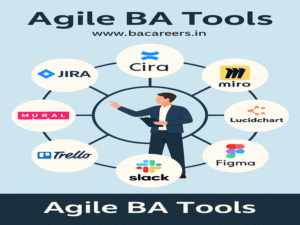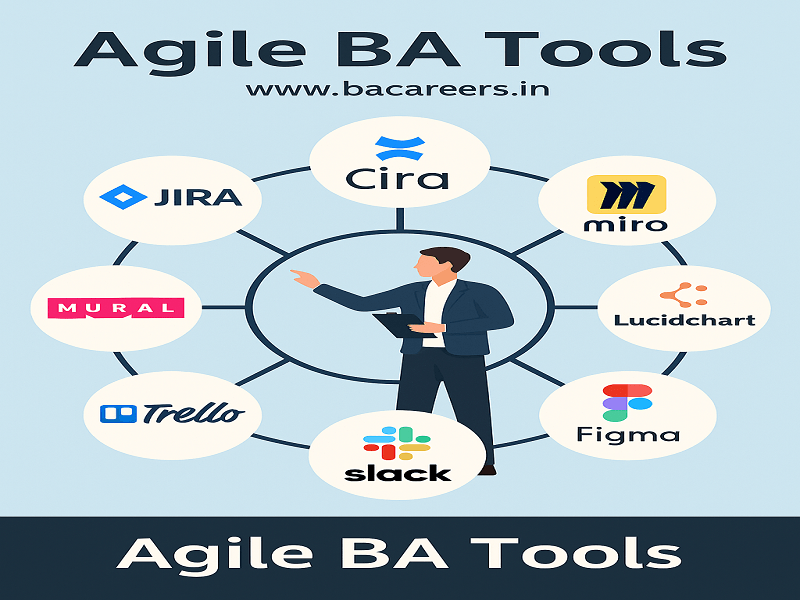Agile BA Tools: Essential Tools for Agile Business Analysts with Real-Time Scenarios
Introduction
In today’s Agile world, Business Analysts (BAs) must do more than gather requirements—they must collaborate, visualize workflows, track progress, and adapt quickly. To succeed in an Agile environment, BAs use a variety of Agile BA tools to streamline communication, documentation, and delivery.
In this article, we’ll explore the top Agile tools for Business Analysts, complete with real-time scenarios and examples to help you understand how and when to use them.

🔍 What Are Agile BA Tools?
Agile BA tools are software applications and platforms that help Business Analysts work efficiently in Agile environments. These tools support:
User story creation
Requirements gathering and tracking
Sprint planning and tracking
Collaboration with stakeholders and teams
Visualization of workflows
Continuous delivery
🛠 Top Agile BA Tools with Real-Time Examples
1. JIRA (by Atlassian)
Purpose: Sprint management, user stories, backlog, and issue tracking.
Real-Time Scenario:
A BA working in an e-commerce company uses JIRA to create and manage user stories for a new “wishlist” feature. Each story is linked to acceptance criteria and assigned to developers. Sprint boards are used to track progress.
Why It’s Useful:
Supports Agile Scrum and Kanban boards
Easy collaboration with developers
Customizable workflows
2. Confluence
Purpose: Agile documentation and team collaboration.
Example:
A BA documents a “Returns and Refunds” policy as a business rule document and links it to related JIRA tickets. Team members can comment, edit, and review the content in real time.
Benefits:
Centralized knowledge base
Links easily with JIRA
Great for documenting meeting notes, user journeys, and project requirements
3. Miro / MURAL
Purpose: Visual collaboration and brainstorming.
Scenario:
While planning a mobile app, the BA uses Miro to run a virtual Design Thinking workshop with stakeholders. They map the customer journey and pain points on a digital whiteboard.
Use Cases:
Mind maps
Customer journey maps
SWOT analysis
Process flows
4. Lucidchart / Draw.io
Purpose: Diagramming and process modeling
Real-Time Use:
A BA at a healthcare startup uses Lucidchart to create a workflow diagram showing how patient appointment data moves through different systems.
Popular Diagrams:
BPMN diagrams
Flowcharts
Wireframes
Use Case Diagrams
5. Trello
Purpose: Lightweight task and story tracking
Scenario:
A BA working with a startup team uses Trello to maintain a feature backlog for their MVP launch. Stories are color-coded based on priority and status.
Benefits:
User-friendly interface
Custom boards and checklists
Great for smaller Agile teams
6. Slack / Microsoft Teams
Purpose: Team communication and real-time collaboration
Example:
A BA integrates Slack with JIRA to receive notifications when stories are moved across the Kanban board.
Benefits:
Immediate feedback from developers
Virtual stand-ups
Easy sharing of files and updates
7. Balsamiq / Figma
Purpose: Wireframing and prototyping
Real-Time Scenario:
A BA creates low-fidelity wireframes of a dashboard and shares them with the UX team and stakeholders using Figma. Real-time comments help improve the design quickly.
Why BAs Love These Tools:
Speedy mockups
Stakeholder validation
Reduce rework during development
🧩 Real-World Use Case: A BA in an Agile Retail Project
Imagine you are a Business Analyst working on a new retail order management system. Here’s how you use these tools:
JIRA to create epics for “Order Processing” and stories for “Order Cancellation”
Confluence to document business rules around refund policies
Miro for collaborative user journey mapping
Lucidchart to design the “Order Lifecycle” workflow
Slack for daily stand-up communication
Figma to prototype the customer order history screen
This toolkit helps you deliver value faster, reduce ambiguity, and improve team collaboration—all critical aspects of Agile Business Analysis.
🔑 Key Takeaways
Agile Business Analysts use tools not just to manage tasks, but to collaborate, visualize, and deliver value quickly.
Tools like JIRA, Confluence, Miro, and Lucidchart are essential in modern Agile environments.
Choosing the right tool depends on the project type, team size, and stakeholder needs.
🔗 Internal and External Links
Internal Links:
External Links:
1. Agile BA Tools
“Explore the top Agile Business Analyst tools that streamline collaboration, improve productivity, and help deliver customer-centric solutions faster in Agile environments.”
2. Best Agile Tools for Business Analysts
“Discover the most effective Agile tools every Business Analyst should know, including JIRA, Confluence, Trello, and more with real-time project use cases.”
3. Agile Business Analysis Tools List
“Comprehensive list of essential Agile BA tools to manage user stories, sprints, stakeholder communication, and documentation effectively.”
4. Business Analyst Tools in Agile Projects
“Learn about key tools used by Business Analysts in Agile projects to manage requirements, create roadmaps, and ensure successful product delivery.”
5. JIRA for Business Analysts
“Understand how Business Analysts use JIRA for backlog management, writing user stories, sprint planning, and tracking Agile workflows.”
6. Confluence for Business Analysts
“Explore how Confluence helps Business Analysts collaborate with teams, document requirements, and maintain transparency in Agile environments.”
7. Agile BA Collaboration Tools
“Top collaboration tools for Agile Business Analysts that help facilitate better communication between stakeholders, developers, and testers.”
8. Business Analyst Software Tools
“Detailed guide on software tools used by BAs in Agile methodology for requirement gathering, modeling, reporting, and agile project tracking.”
9. Business Analyst Tools with Examples
“Practical examples of how tools like JIRA, Balsamiq, Lucidchart, and Trello are used by Agile Business Analysts in real-world projects.”
10. Agile Business Analyst Toolkit
“Curated toolkit for Agile Business Analysts featuring tools for documentation, process modeling, story mapping, and stakeholder engagement.”

Business Analyst , Functional Consultant, Provide Training on Business Analysis and SDLC Methodologies.

